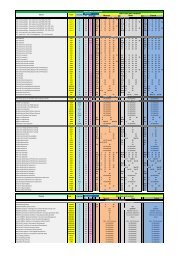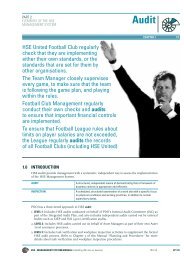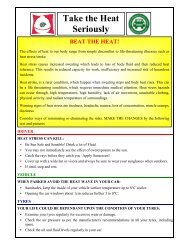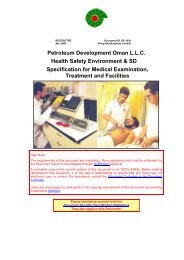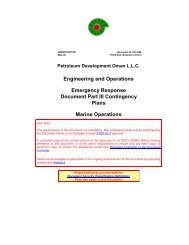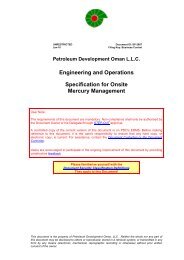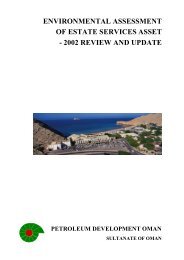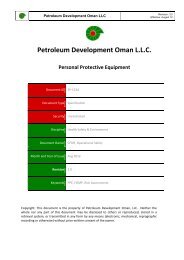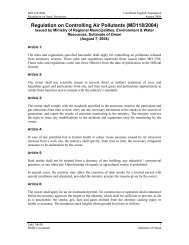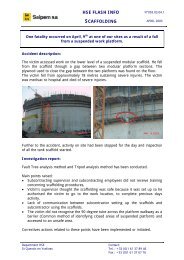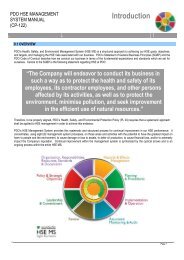Shell Exploration & Production Contractor HSE Management - PDO
Shell Exploration & Production Contractor HSE Management - PDO
Shell Exploration & Production Contractor HSE Management - PDO
- No tags were found...
You also want an ePaper? Increase the reach of your titles
YUMPU automatically turns print PDFs into web optimized ePapers that Google loves.
EP2005 Volume 1<strong>HSE</strong> Procedure<strong>Contractor</strong> <strong>HSE</strong> <strong>Management</strong>(including Stoplight)RestrictedEP2005-0110-PR-10PlanningTask 1: Assess and analyse <strong>HSE</strong> risksCategorise each contract as Low <strong>HSE</strong> Risk, Medium <strong>HSE</strong> Risk orHigh <strong>HSE</strong> Risk corresponding to the highest risk inherent in thecontract scope as follows:1. Identify all Hazards associated with activities in the contractwork scope, covering but not limited to the following:• Nature of the work - work methods, staffing, materials,equipment, tools to be used and associated hazards e.g.lifting, working at heights, transport, etc;• Nature of the product or service i.e. is the contractorrequired to perform an <strong>HSE</strong> critical activity (such as thedesign <strong>HSE</strong>-critical equipment) as opposed to a hazardousactivity (such as working at height);• Location of the work - vicinity of shops, schools, hospitals,offices, houses; environmentally sensitive locations(beaches, coral reefs, fishing areas, etc), and associatedhazards e.g. H 2 S, asbestos, chemicals and heat;• Local constraints;• Number of concurrent operations or contractors on site;• Potential consequences – environmental harm, injury,illness, asset damage, impact on local societal sensitivities,reputation with Non-Governmental Organisations (NGO) orGovernments, etc.To minimise the assessment effort and to ensure consistencyassessors shall refer to the relevant hazards & environmentalaspects registers of the EP Company, the EP Standard ‘Hazardsand Effects <strong>Management</strong> Process’ (HEMP) [11] and other <strong>HSE</strong>risk assessments maintained at the SCM Category level or byindustry (e.g. OGP).2. Assess the <strong>HSE</strong> risk of each Hazard using the Group (YG) ‘RiskAssessment Matrix’ (RAM) [23, §2.1].3. Document the <strong>HSE</strong> risk assessment.Task 2: Categorise mode of contractCategorise the contract as Mode1, Mode 2 or Mode 3:Mode 1 contract:‘The contractor provides people and tools for the execution of thework under the supervision, instructions and <strong>HSE</strong> <strong>Management</strong>System of the company. The contractor has a <strong>Management</strong> Systemto provide assurance that the personnel for whom he is responsibleare qualified and healthy for the job and that the tools and machineryhe is providing are properly maintained and suitable for the job’ 2 .Mode 2 contract:‘The contractor executes all aspects of the job under its own <strong>HSE</strong><strong>Management</strong> System, provides the necessary instructions andsupervision and verifies the proper functioning of its <strong>HSE</strong><strong>Management</strong> System. The company is responsible for verifying theoverall effectiveness of the <strong>HSE</strong> management controls put in placeby the contractor, and assuring that both the company’s and thecontractor’s <strong>HSE</strong>-MS are appropriately compatible’ 2 .2 Definition from OGP <strong>HSE</strong> <strong>Management</strong> – ‘Guideline for working together ina contract environment [25]’Doc. No:EP200406372810Version:2Date:30 August 2006Org. Doc. No: EP2005-0110-PR-10Custodian:EPS-<strong>HSE</strong>ECCN: Not subject to EAR Page:No US content4 of 13Printed copies are uncontrolled.



